Jialin Chen
Analyzing Gait Adaptation with Hemiplegia Simulation Suits and Digital Twins
Sep 05, 2025



Abstract:To advance the development of assistive and rehabilitation robots, it is essential to conduct experiments early in the design cycle. However, testing early prototypes directly with users can pose safety risks. To address this, we explore the use of condition-specific simulation suits worn by healthy participants in controlled environments as a means to study gait changes associated with various impairments and support rapid prototyping. This paper presents a study analyzing the impact of a hemiplegia simulation suit on gait. We collected biomechanical data using a Vicon motion capture system and Delsys Trigno EMG and IMU sensors under four walking conditions: with and without a rollator, and with and without the simulation suit. The gait data was integrated into a digital twin model, enabling machine learning analyses to detect the use of the simulation suit and rollator, identify turning behavior, and evaluate how the suit affects gait over time. Our findings show that the simulation suit significantly alters movement and muscle activation patterns, prompting users to compensate with more abrupt motions. We also identify key features and sensor modalities that are most informative for accurately capturing gait dynamics and modeling human-rollator interaction within the digital twin framework.
TRACE: Grounding Time Series in Context for Multimodal Embedding and Retrieval
Jun 10, 2025Abstract:The ubiquity of dynamic data in domains such as weather, healthcare, and energy underscores a growing need for effective interpretation and retrieval of time-series data. These data are inherently tied to domain-specific contexts, such as clinical notes or weather narratives, making cross-modal retrieval essential not only for downstream tasks but also for developing robust time-series foundation models by retrieval-augmented generation (RAG). Despite the increasing demand, time-series retrieval remains largely underexplored. Existing methods often lack semantic grounding, struggle to align heterogeneous modalities, and have limited capacity for handling multi-channel signals. To address this gap, we propose TRACE, a generic multimodal retriever that grounds time-series embeddings in aligned textual context. TRACE enables fine-grained channel-level alignment and employs hard negative mining to facilitate semantically meaningful retrieval. It supports flexible cross-modal retrieval modes, including Text-to-Timeseries and Timeseries-to-Text, effectively linking linguistic descriptions with complex temporal patterns. By retrieving semantically relevant pairs, TRACE enriches downstream models with informative context, leading to improved predictive accuracy and interpretability. Beyond a static retrieval engine, TRACE also serves as a powerful standalone encoder, with lightweight task-specific tuning that refines context-aware representations while maintaining strong cross-modal alignment. These representations achieve state-of-the-art performance on downstream forecasting and classification tasks. Extensive experiments across multiple domains highlight its dual utility, as both an effective encoder for downstream applications and a general-purpose retriever to enhance time-series models.
Towards Non-Euclidean Foundation Models: Advancing AI Beyond Euclidean Frameworks
May 20, 2025Abstract:In the era of foundation models and Large Language Models (LLMs), Euclidean space is the de facto geometric setting of our machine learning architectures. However, recent literature has demonstrated that this choice comes with fundamental limitations. To that end, non-Euclidean learning is quickly gaining traction, particularly in web-related applications where complex relationships and structures are prevalent. Non-Euclidean spaces, such as hyperbolic, spherical, and mixed-curvature spaces, have been shown to provide more efficient and effective representations for data with intrinsic geometric properties, including web-related data like social network topology, query-document relationships, and user-item interactions. Integrating foundation models with non-Euclidean geometries has great potential to enhance their ability to capture and model the underlying structures, leading to better performance in search, recommendations, and content understanding. This workshop focuses on the intersection of Non-Euclidean Foundation Models and Geometric Learning (NEGEL), exploring its potential benefits, including the potential benefits for advancing web-related technologies, challenges, and future directions. Workshop page: [https://hyperboliclearning.github.io/events/www2025workshop](https://hyperboliclearning.github.io/events/www2025workshop)
DYNUS: Uncertainty-aware Trajectory Planner in Dynamic Unknown Environments
Apr 24, 2025

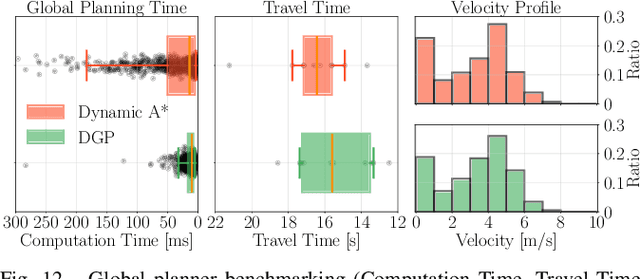

Abstract:This paper introduces DYNUS, an uncertainty-aware trajectory planner designed for dynamic unknown environments. Operating in such settings presents many challenges -- most notably, because the agent cannot predict the ground-truth future paths of obstacles, a previously planned trajectory can become unsafe at any moment, requiring rapid replanning to avoid collisions. Recently developed planners have used soft-constraint approaches to achieve the necessary fast computation times; however, these methods do not guarantee collision-free paths even with static obstacles. In contrast, hard-constraint methods ensure collision-free safety, but typically have longer computation times. To address these issues, we propose three key contributions. First, the DYNUS Global Planner (DGP) and Temporal Safe Corridor Generation operate in spatio-temporal space and handle both static and dynamic obstacles in the 3D environment. Second, the Safe Planning Framework leverages a combination of exploratory, safe, and contingency trajectories to flexibly re-route when potential future collisions with dynamic obstacles are detected. Finally, the Fast Hard-Constraint Local Trajectory Formulation uses a variable elimination approach to reduce the problem size and enable faster computation by pre-computing dependencies between free and dependent variables while still ensuring collision-free trajectories. We evaluated DYNUS in a variety of simulations, including dense forests, confined office spaces, cave systems, and dynamic environments. Our experiments show that DYNUS achieves a success rate of 100% and travel times that are approximately 25.0% faster than state-of-the-art methods. We also evaluated DYNUS on multiple platforms -- a quadrotor, a wheeled robot, and a quadruped -- in both simulation and hardware experiments.
Towards A Universal Graph Structural Encoder
Apr 15, 2025Abstract:Recent advancements in large-scale pre-training have shown the potential to learn generalizable representations for downstream tasks. In the graph domain, however, capturing and transferring structural information across different graph domains remains challenging, primarily due to the inherent differences in topological patterns across various contexts. Additionally, most existing models struggle to capture the complexity of rich graph structures, leading to inadequate exploration of the embedding space. To address these challenges, we propose GFSE, a universal graph structural encoder designed to capture transferable structural patterns across diverse domains such as molecular graphs, social networks, and citation networks. GFSE is the first cross-domain graph structural encoder pre-trained with multiple self-supervised learning objectives. Built on a Graph Transformer, GFSE incorporates attention mechanisms informed by graph inductive bias, enabling it to encode intricate multi-level and fine-grained topological features. The pre-trained GFSE produces generic and theoretically expressive positional and structural encoding for graphs, which can be seamlessly integrated with various downstream graph feature encoders, including graph neural networks for vectorized features and Large Language Models for text-attributed graphs. Comprehensive experiments on synthetic and real-world datasets demonstrate GFSE's capability to significantly enhance the model's performance while requiring substantially less task-specific fine-tuning. Notably, GFSE achieves state-of-the-art performance in 81.6% evaluated cases, spanning diverse graph models and datasets, highlighting its potential as a powerful and versatile encoder for graph-structured data.
MTBench: A Multimodal Time Series Benchmark for Temporal Reasoning and Question Answering
Mar 21, 2025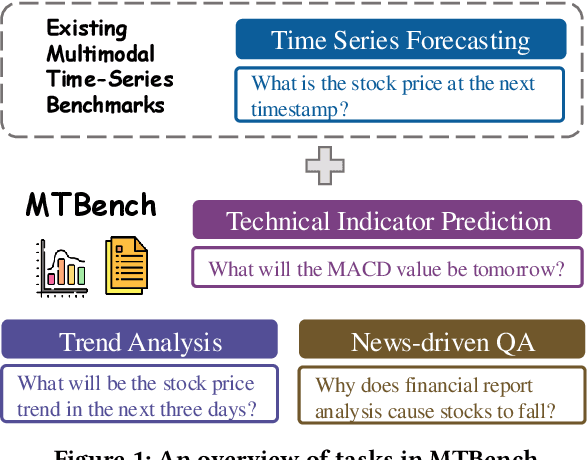

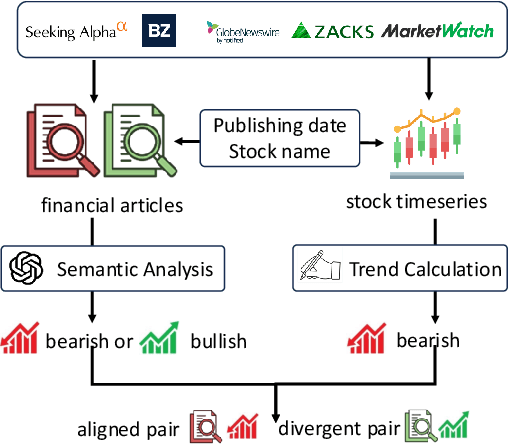

Abstract:Understanding the relationship between textual news and time-series evolution is a critical yet under-explored challenge in applied data science. While multimodal learning has gained traction, existing multimodal time-series datasets fall short in evaluating cross-modal reasoning and complex question answering, which are essential for capturing complex interactions between narrative information and temporal patterns. To bridge this gap, we introduce Multimodal Time Series Benchmark (MTBench), a large-scale benchmark designed to evaluate large language models (LLMs) on time series and text understanding across financial and weather domains. MTbench comprises paired time series and textual data, including financial news with corresponding stock price movements and weather reports aligned with historical temperature records. Unlike existing benchmarks that focus on isolated modalities, MTbench provides a comprehensive testbed for models to jointly reason over structured numerical trends and unstructured textual narratives. The richness of MTbench enables formulation of diverse tasks that require a deep understanding of both text and time-series data, including time-series forecasting, semantic and technical trend analysis, and news-driven question answering (QA). These tasks target the model's ability to capture temporal dependencies, extract key insights from textual context, and integrate cross-modal information. We evaluate state-of-the-art LLMs on MTbench, analyzing their effectiveness in modeling the complex relationships between news narratives and temporal patterns. Our findings reveal significant challenges in current models, including difficulties in capturing long-term dependencies, interpreting causality in financial and weather trends, and effectively fusing multimodal information.
Low-Rank Adaptation for Foundation Models: A Comprehensive Review
Dec 31, 2024Abstract:The rapid advancement of foundation modelslarge-scale neural networks trained on diverse, extensive datasetshas revolutionized artificial intelligence, enabling unprecedented advancements across domains such as natural language processing, computer vision, and scientific discovery. However, the substantial parameter count of these models, often reaching billions or trillions, poses significant challenges in adapting them to specific downstream tasks. Low-Rank Adaptation (LoRA) has emerged as a highly promising approach for mitigating these challenges, offering a parameter-efficient mechanism to fine-tune foundation models with minimal computational overhead. This survey provides the first comprehensive review of LoRA techniques beyond large Language Models to general foundation models, including recent techniques foundations, emerging frontiers and applications of low-rank adaptation across multiple domains. Finally, this survey discusses key challenges and future research directions in theoretical understanding, scalability, and robustness. This survey serves as a valuable resource for researchers and practitioners working with efficient foundation model adaptation.
DTGB: A Comprehensive Benchmark for Dynamic Text-Attributed Graphs
Jun 17, 2024



Abstract:Dynamic text-attributed graphs (DyTAGs) are prevalent in various real-world scenarios, where each node and edge are associated with text descriptions, and both the graph structure and text descriptions evolve over time. Despite their broad applicability, there is a notable scarcity of benchmark datasets tailored to DyTAGs, which hinders the potential advancement in many research fields. To address this gap, we introduce Dynamic Text-attributed Graph Benchmark (DTGB), a collection of large-scale, time-evolving graphs from diverse domains, with nodes and edges enriched by dynamically changing text attributes and categories. To facilitate the use of DTGB, we design standardized evaluation procedures based on four real-world use cases: future link prediction, destination node retrieval, edge classification, and textual relation generation. These tasks require models to understand both dynamic graph structures and natural language, highlighting the unique challenges posed by DyTAGs. Moreover, we conduct extensive benchmark experiments on DTGB, evaluating 7 popular dynamic graph learning algorithms and their variants of adapting to text attributes with LLM embeddings, along with 6 powerful large language models (LLMs). Our results show the limitations of existing models in handling DyTAGs. Our analysis also demonstrates the utility of DTGB in investigating the incorporation of structural and textual dynamics. The proposed DTGB fosters research on DyTAGs and their broad applications. It offers a comprehensive benchmark for evaluating and advancing models to handle the interplay between dynamic graph structures and natural language. The dataset and source code are available at https://github.com/zjs123/DTGB.
From Similarity to Superiority: Channel Clustering for Time Series Forecasting
Mar 31, 2024

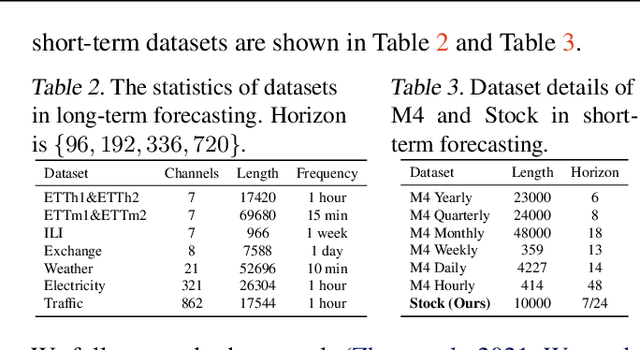

Abstract:Time series forecasting has attracted significant attention in recent decades. Previous studies have demonstrated that the Channel-Independent (CI) strategy improves forecasting performance by treating different channels individually, while it leads to poor generalization on unseen instances and ignores potentially necessary interactions between channels. Conversely, the Channel-Dependent (CD) strategy mixes all channels with even irrelevant and indiscriminate information, which, however, results in oversmoothing issues and limits forecasting accuracy. There is a lack of channel strategy that effectively balances individual channel treatment for improved forecasting performance without overlooking essential interactions between channels. Motivated by our observation of a correlation between the time series model's performance boost against channel mixing and the intrinsic similarity on a pair of channels, we developed a novel and adaptable Channel Clustering Module (CCM). CCM dynamically groups channels characterized by intrinsic similarities and leverages cluster identity instead of channel identity, combining the best of CD and CI worlds. Extensive experiments on real-world datasets demonstrate that CCM can (1) boost the performance of CI and CD models by an average margin of 2.4% and 7.2% on long-term and short-term forecasting, respectively; (2) enable zero-shot forecasting with mainstream time series forecasting models; (3) uncover intrinsic time series patterns among channels and improve interpretability of complex time series models.
Qubit-Wise Architecture Search Method for Variational Quantum Circuits
Mar 07, 2024
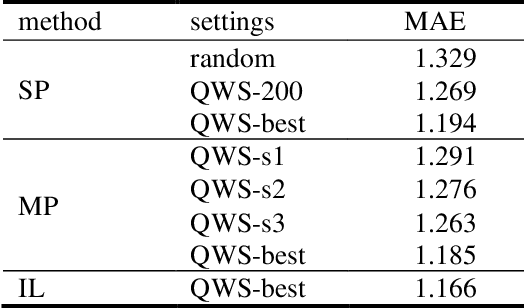

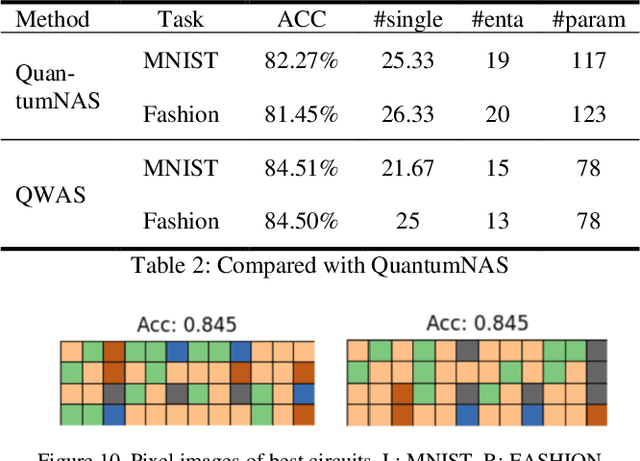
Abstract:Considering the noise level limit, one crucial aspect for quantum machine learning is to design a high-performing variational quantum circuit architecture with small number of quantum gates. As the classical neural architecture search (NAS), quantum architecture search methods (QAS) employ methods like reinforcement learning, evolutionary algorithms and supernet optimiza-tion to improve the search efficiency. In this paper, we propose a novel qubit-wise architec-ture search (QWAS) method, which progres-sively search one-qubit configuration per stage, and combine with Monte Carlo Tree Search al-gorithm to find good quantum architectures by partitioning the search space into several good and bad subregions. The numerical experimental results indicate that our proposed method can balance the exploration and exploitation of cir-cuit performance and size in some real-world tasks, such as MNIST, Fashion and MOSI. As far as we know, QWAS achieves the state-of-art re-sults of all tasks in the terms of accuracy and circuit size.
 Add to Chrome
Add to Chrome Add to Firefox
Add to Firefox Add to Edge
Add to Edge